
Official Edgar Rice Burroughs Tribute and Weekly Webzine Site Since 1996 ~ Over 15,000 Webpages in Archive |

Official Edgar Rice Burroughs Tribute and Weekly Webzine Site Since 1996 ~ Over 15,000 Webpages in Archive |
![]()
A Proppian Analysis of "Tarzan
Jr."
By
David "Nkima" Adams
![]()
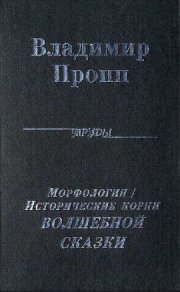
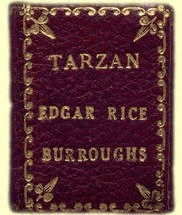
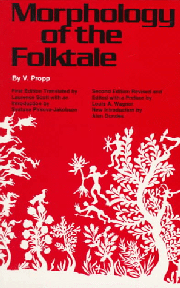
Foreword Edgar Rice Burroughs wrote two stories intended specifically for children. They are: The Tarzan Twins (1926) and Tarzan and the Tarzan Twins with Jad-Bal-Ja, the Golden Lion (1928). These have been long considered to be among ERB's lesser writings until they were realized to be little masterworks in the genre of fairy tales when I applied Propp's system of structural analysis to them. (What a good boy am I!).
The great, Russian folklorist, Vladimir Propp (1895-1970) published his first book, Morphology of the Folktale in 1928. Though well-received, the book remained in relative obscurity until it was translated into English in 1958. (Then it caused quite a stir that other folklorists have not really gotten over even to this day.)
The interesting thing about Propp's work is the fact that he developed a method to study the folktale according to the functions of its dramatis personae. He claims that these "functions" or acts of a character are limited in number and follow a more or less identical sequence. The word "morphology" simply means the study of forms -- the study of component parts in their relationships to each other and to the whole -- in other words, the study of the story's structure. (This might make your head hurt when you think about it even a little bit, so you should be careful.)
Since Edgar Rice Burroughs is recognized as being a great story teller, I wondered if Propp's functions could be applied to his two Tarzan Twins stories. After finding them to be exemplary examples of the wondertale, or fairy tale, I turned my attention to his earlier stories, the Jungle Tales of Tarzan of 1916-1917.
Burroughs wrote his Jungle Tales in two batches: (1-8) in 1916, and (9-12) in 1917. These short stories are a rarity with Burroughs the novelist. The stories are related to each other, yet each one is complete in itself. Unlike the Tarzan Twins stories, these tales were not intended specifically for children, however, they do follow the sequence of Propp's functions remarkably well.
The other evening as I was wandering among Bill Hillman's internet pages, I found "Tarzan Jr" lurking amongst his many colorful screens. "Oops," I said, "I forgot to apply Propp to this story. I thought it should fit the form, and it did as well as any other fairy tale by ERB. Here it is fans. How much my tongue protrudes into my cheek is up to
your own judgment.
The Functions of Dramatis Personae
in Propp's Morphology of the FolktaleI. One of the members of a family absents himself from home. Sometimes members of the younger generation absent themselves -- they go visiting.
(The little princess was walking in the garden when a bad thought sneaked up behind her and whispered in her ear, "Go into the forbidden forest.")
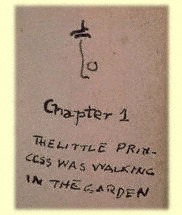
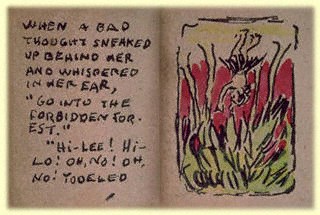
II. An interdiction is addressed to the hero.("My Mama said I mustn't go into the forbidden forest, and my papa said she ought to know.")
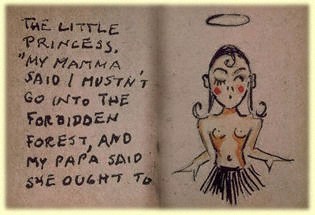
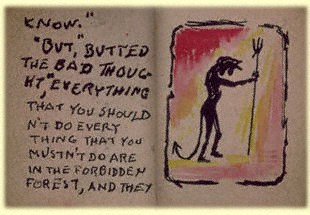
III. The interdiction is violated, and a villain enters the tale(So the little princess put a nutty hamburger in a shoe box for her lunch, vaulted over the garden wall and went into the forbidden forest.)
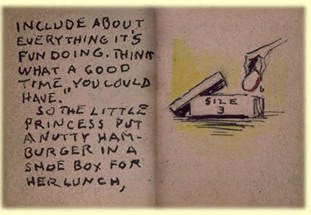
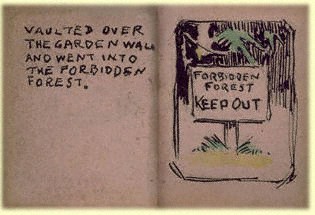
IV. The villain makes an attempt at reconnaissance.(The little princess had not gone far into the dark and gloomy wood when she met Histah the snake.)
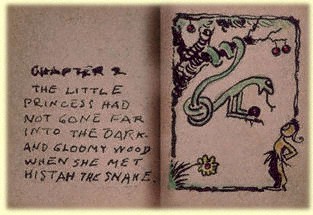
V. The villain receives information about his victim.(Given the brevity of this story, the princess simply meets the snake without further ado.)
VI. The villain attempts to deceive his victim in order to take possession of him or of his belongings.
("Have an apple," invited Histah.) Ooh, it's the Garden of Eden again.
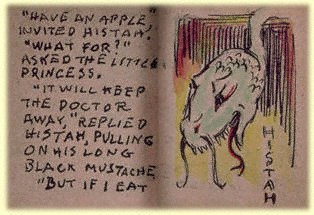
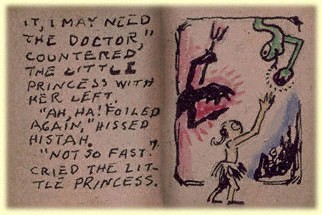
VII. The victim submits to deception and thereby unwittingly helps his enemy.("Gimme the apple," for the bad thought had again whispered in her ear.
Naughty little Eve. Hadn't she ever read the Bible?)
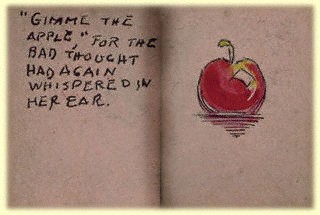
VIII. The villain causes harm or injury to a member of a family.(Tantor the elephant appears before the villainy can occur. He is the first hero of the tale.)
VIIIa. One member of a family either lacks something or desires to have something.
(The princess wants the apple.)
IX. Misfortune or lack is made known; the hero is approached with a request or command; he is allowed to go or he is dispatched.
(There is no misfortune because Tantor barges up and takes the apple.)
X. The seeker agrees to or decides upon counteraction.
(The hero, Tantor, eats the apple himself.)
XI. The hero leaves home. Unlike the first absence element, this one is marked with a search for a goal.
(Tantor asks about the nutty hamburger.)
XII. The hero is tested, interrogated, attacked, etc., which prepares the way for his receiving either a magical agent or helper.
(Tantor asks the princess what she has in the shoe box.)
XIII. The hero reacts to the actions of the future donor. He performs a service of some kind, such as showing mercy.
(Tantor 's takes over the "psychological danger of the "nutty" hamburger.)
XIV. The hero acquires the use of a magical agent. This may be a capacity, such as the power of transformation into animals, etc., or an agent is eaten or drunk.
(Tantor eats the nutty hamburger, which is just "nutty," not dementia praecox, and thereby prevents a homicidal mania, which may have threatened the princess. Tantor goes into the land of ptomaine, which makes the appearance of another hero necessary.)
XV. The hero is transferred, delivered, or led to the whereabouts of an object of search. Generally the object of search is located in "another" or "different" kingdom.
(The little princess was very hungry; so she went deeper into the dark, damp wood looking for another snake with an apple.)
XVI. The hero and the villain join in direct combat. In humorous tales the fight itself sometimes does not occur. The hero and the villain may engage in a competition . The hero wins with the help of cleverness.
(Numa the lion stalks the princess, and as there are not many callories (sic) in stalks, he plans on eating the little princess. Tarzan Jr.prevents the eating by dropping upon the tawny back of the carnivore.)
XVII. The hero is branded.
(Tarzan Jr. is a bronzed giant, naked but for a G-string. He is bronzed instead of branded.)
XVIII. The villain is defeated.
(Tarzan Jr. kills the lion with his gleaming blade.)
XIX. The initial misfortune or lack is liquidated.
(The lion is killed.)
XX. The hero returns.
(This is indeed the famous Tarzan, the Lord of the Jungle. We can tell this because he places a foot upon the carcass of his kill, raises his face to the heavens, and voices the cry of the bull ape.)
XXI. The hero is pursued.
(This step is not in this brief tale.)
XXII. Rescue of the hero from pursuit.
(This step is not necessary because there is no further pursuit.)
XXIII. The hero, unrecognized, arrives home or in another country.
(The story is too brief for this step.)
XXIV. A false hero presents unfounded claims.
(There is no false hero in this story.)
XXV. A difficult task is proposed to the hero. These ordeals are so varied that each would need a special designation.
(The little princess was still hungry. "Let's eat the lion," she said,"unless you happen to have an apple in your pocket.")
XXVI. The task is resolved.
(Since Tarzan does not have a pocket, they decide to "skip it.")
XXVII. The hero is recognized. This may be a special mark or a simple recognition of accomplishments.
(Tarzan Jr. uncoils his rope and they skipped.)
XXVIII. The false hero or villain is exposed. Sometimes all the events are recounted from the very beginning in the form of a tale.
(I've already told you, there is no false hero.)
XXIX. The hero is given a new appearance. Transfiguration. Sometimes a change of dress.
(Tarzan Jr. changes from being a heroic killer of lions into a comic figure skipping rope. Note: "You are a comic little figure, hopping from the cradle to the grave." ERB in his Caspakian Love/Death Trilogy.)
XXX. The villain is punished.
(There is a final illustration: "Keep Out" with a Red X over the
sign. No one can keep us out of this New Eden of Tarzan and the
Princess.)XXXI. The hero is married and ascends the throne.
(Tarzan Jr. marries the princess and they live happily forever after. That's what the little princess gets for disobeying her mama and going into the Forbidden Forest.)
Propp works quite well for Tarzan Jr. That's because ERB always instinctively knew what he was doing when he was writing even if it was a silly little vignette like this one. The amazing thing is the fact that he plays around with psychological word games even in this trifle, but that's not really so amazing at all because his normal bean always worked this way. Burroughs was a universal natural when all the gears were spinning.
ERB was always spinning. "Hi-Lee! Hi-Lo! Oh, No! Oh, No!"
January 30, 2000
David Adams
BACK TO MAIN PAGE FOR ERBzine
www.ERBzine.com
![]() .
WEBJED:
BILL HILLMAN .
.
WEBJED:
BILL HILLMAN .![]()
Visit
our thousands of other sites at:
BILL
and SUE-ON HILLMAN ECLECTIC STUDIO
Some
ERB Images and Tarzan© are Copyright ERB, Inc.- All Rights Reserved.
All
Original Work ©1996-2006/2018 by Bill Hillman and/or Contributing
Authors/Owners
No
part of this web site may be reproduced without permission from the respective
owners.